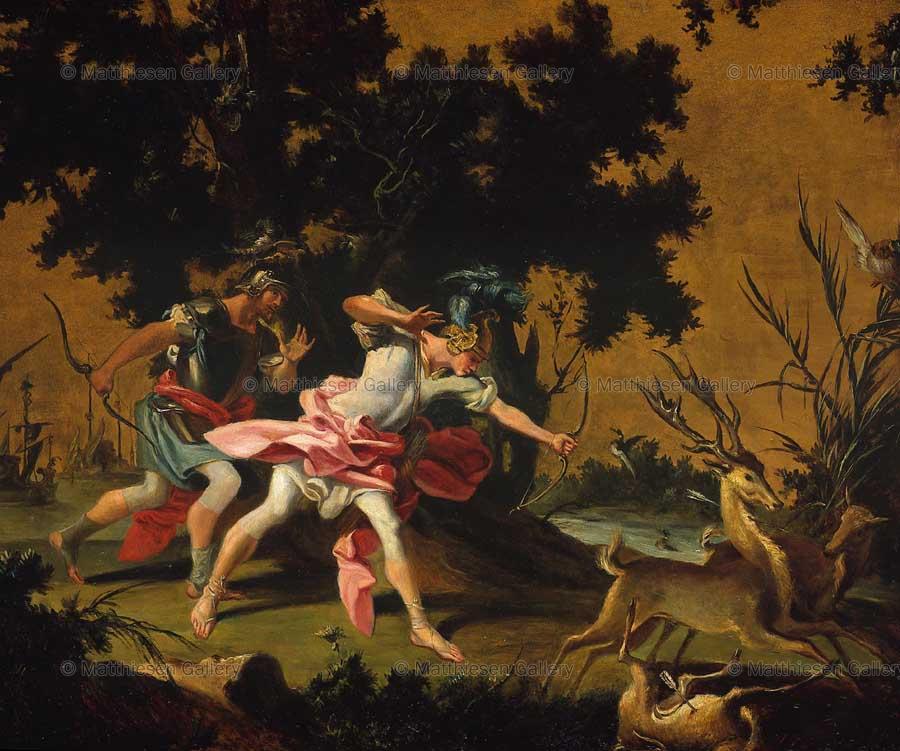Aeneas and Achates hunting Stags on the Coast of Libya(Filippo Falciatore)
The two paintings illustrate, respectively, two episodes from the Story of Dido and Aeneas from Virgils Aeneid. Achates was one of Aeneas most trusted captains. The goddess Juno, who had taken the side of the Greeks against the Trojans persuaded Aeolus to release the winds in order to cause a storm to destroy the Trojan fleet. Some of Aeneas ships were wrecked but several made safe haven, among them one commanded by Achates. Sheltering from the fury of the wind in a cave Aeneas later climbed on top of the rocks and espied first a single stag and then a herd of deer and the two gave chase. This is the scene the artist has chosen to depict though the anchored fleet appears to be in calm waters and the landscape is more reminsicent of the Campania than the north African coast! The pair kill seven weighty carcasses in number equal to the surviving Trojan ships. Aeneas organises a splendid barbecue and lectures his men on their destiny. Later in the story upon their arrival in Carthage it is Achates that Aeneas sends to fetch the alluring presents with which he intends to spoil the beautiful Dido. Thus the artist skillfully and obviously quite intentionally links the stories which he depicts in these two paintings.[1]
The paintings originally made up part of a series of decorative panels in eighteenth century European rocaille style, either for a cabinet, a matrimonial bedhead or a sedan chair. The panels are certainly by Filippo Falciatore on account of their close stylistic affinity to other signed or securely attributed works by this Neapolitan petit-maître who was active at the Court of Charles Bourbon of Naples in the middle of the century. A further five panels in the Duca di Martina Museum in Naples have always unanimously been given to Falciatore (See Fig. 1). On gold backgrounds and in mock Rococo frames, finely painted with floral motifs, they illustrate various mythological episodes. On the basis of De Dominicis biography[2] they were identified by Vitzthum[3] as being the panels painted by Falciatore between 1737 and 1738, for the sedan chair of Maria Amalia of Sassonia, wife of Charles Bourbon, King of Naples (identified also by Spinosa, as dating after 1741 for their affinity to other paintings by Falciatore after this date). These panels are considered to be amongst the finest and most precious examples of the Neapolitan Rococo style and many other pictures from the artists maturity are similar in style often with genre scenes taken from daily life in Naples mid century at a time when the artist was enjoying his greatest success. They are also very close in style to a further panel, whose theme taken from Gerusalemme liberata by Torquato Tasso, is the episode of Erminia amongst the shepherds. This panel is mounted in a fine carved, gold, wooden frame in the rocaille style, and it appeared at auction at Sothebys in London in 1985 (See Fig. 2). Originally it must definitely have been part of the pictorial decoration of a sedan chair.
After a brief period in the workshops of Paolo de Matties, Falciatore was influenced by the neo-mannerist style of Domenico Antonio Vaccaro to whom he was apprenticed shortly before 1741 and whose formal style and chromatic values are reflected in the exhibited panels. All the decorative panels discussed here may be dated to a period sometime after 1735 and the end of the decade which according to De Dominici is the time that Maria Amalia of Saxonys sedan chair was decorated.
NOTES
[1] Book I, verses 180-210, and Book IV verses 129-159. For the story of the hunt and Dido and Aeneas see Solimena no.2 in this catalogue.
[2] B. de Dominici, Vite dei Pittori, Scultori e Architetti Napoletani, Naples 1742-3, III, p. 494.
[3] W. Vitzhum, Filippo Falciatore Petit Maître oublié du style Rocaille a Naples LOeil, 1967, pp. 18-23; See also N. Spinosa, Le arti figurative a Napoli nel Settecento: Documenti e ricerche, Naples, 1979: N. Spinosa, Pittura napoletana del Settecento dal Barocco al Rococo, Naples, 1987, p. 153, no. 230, figs. 275, 276 and pls. 49 and 50.
Matthiesen Gallery, London, ‘The Settecento’, 1999

